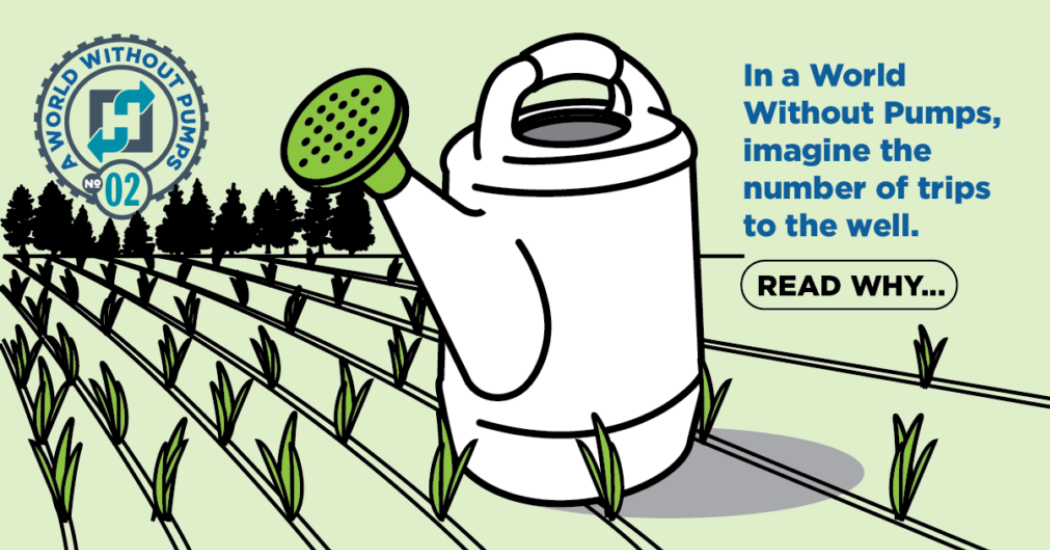After the Rain, Pumps Grow Our Crops and Green Our Lawns
For thousands of years, rain was the only practical way to irrigate crops. Without pumps, there was no reliable way to deliver the water needed to make things grow. Farmers and growers faced dry years and crop failures. And it goes beyond that. Growing nourishing forage for animals that provide our meat, milk and cheese was a challenge. Livestock had to be watered from hand-drawn wells or natural bodies of water. The water people needed for daily activities such as cooking, washing and drinking also had to be drawn from wells or carried in buckets from springs. Back and forth, can you imagine the trips?
Agriculture is a one of the biggest users of water today and was also in the past. In areas where there is little rainfall, crops must receive most or all of their water by irrigation. In other areas, irrigation augments natural rainfall and helps to provide just the right amount of water each plant needs. Evidence of irrigation dates as far back as about 6000 BC. The Indus Valley Civilization, which covered much of present-day Afghanistan, Pakistan and India, developed sophisticated irrigation and water storage systems with artificial reservoirs and extensive networks of irrigation canals between 3000 and 2600 BC. Without pumps, however, the volume of water they could move was limited. Around a thousand years later, the Ancient Nubians used a waterwheel-like device to help move water from a natural lake formed by the flooding of the Nile. It still was not a pump, but civilization was working toward more efficient ways of moving needed water. Roman settlers in North Africa used a water wheel with clay pots around the rim, powered by the flow of the stream or by animals where the water source was still. A little later, the Chinese used chain pumps that lifted water from a lower elevation to a higher one. These were powered by a manual foot pedal, a water wheel or rotating mechanical wheels pulled by oxen.
Crop Irrigation Today
Flood (gravity) irrigation is still practiced in the southwestern U.S., parts of Mexico and many other countries. For ages, ditches or canals have transported water by gravity from rivers or reservoirs, controlled by simple gates. In these hot, arid and often windy areas, flood irrigation conserves water rather than spraying it into the air, where it quickly evaporates. But today, pumps have augmented natural flow, delivering water dependably into the irrigation ditches, mainly from wells. These wells can be as deep as several hundred feet, depending on the level of the water table. In some areas, a centrifugal pump driven by engine or electric motor lifts the water to the surface and delivers it into the channels. A submersible turbine pump driven by an electric motor also may be used. In some cases, a centrifugal pump may be used to transport water directly from a reservoir, lake or stream into the channels.
More common in developed countries is sprinkler or overhead irrigation, in which water from a well or other source is pumped through pipes to one or more central locations in a field and distributed by overhead sprinklers. They may be mounted on permanently installed risers or automatically moving wheeled platforms connected to the pump or other water system by a hose. For larger areas, center pivot irrigation systems made of several segments of pipe joined together and supported by trusses are mounted on wheeled towers, with sprinkler heads positioned along their length. The system moves in a circular pattern, fed with water from the pivot point, either pumped from a well or central system.
Beyond Crops
While irrigation systems are essential for growing the crops that nourish us and feed the animals that are part of our food supply, they have many other applications as well. Without an ample supply of water, we’d have no lush, green lawns, manicured greens and fairways or landscapes with fountains and water features. These applications rely on either a municipal or private water system or individual wells, each with its own type of pump. Large pumps create the pressure in municipal systems, while about 60 percent of domestic home wells in the United States use electric submersible pumps or surface mounted centrifugal pump when the water table level allows. Even in a system based on water towers, a pump lifts the water from a well into the tower, which then feeds the system by gravity.
Environmental Benefits
Water was not recognized as a scarce resource until the 1960s. Adding pumps to irrigation systems has provided several environmental benefits. Because the volume and pressure of the pumps can be controlled and their running cycles programmed, less water is wasted and more is directed to the desired outcome, whether it’s growing crops or providing water for other purposes. Pumps also enable the use of drainage water (sometimes called “gray water”) for irrigation applications such as landscaping. One example is a golf course that waters its fairways and greens in this manner. In the end, the pumps that power our irrigation systems improve our quality of life and use our resources more efficiently.
Check out the other World Without Pumps!
Learn more from the Hydraulic Institute.




